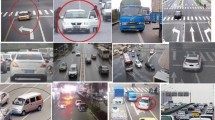Abstract
The choice of driving speed is a function of how safe a driver feels while driving in a particular road segment, and this is influenced by the road and roadside conditions. Researchers tried to study the effect of various road elements like road geometry, lane width and condition, shoulder width and condition and various roadside elements and hazards like presence of poles, trees, etc., on choice of driving speed for various class of vehicles. However, limited work attempted to associate various road alignments, shoulder conditions and parking conditions with the level of driving safety provided by the two-lane rural highways for bus drivers. This paper aimed to study the effect of road alignment, shoulder condition and parking on speed and perceived safety of two-lane rural highways using field and subjective driving experiments for Indian bus drivers. Effects of the road and shoulder conditions on speed and perceived safety ratings were analysed using multivariate analysis of variance (MANOVA). The work also aimed to classify highway segments into five level of service of safety (LOSS) groups based on driving speed and safety perception using centroid-based machine learning clustering algorithm, K-Means clustering algorithm, and associate different road alignment, shoulder conditions and parking conditions with different LOSS groups. The LOSS groups provide an insight into the degree to which road alignment, shoulder condition and parking condition influence the safety perceptions of highways. The LOSS groups also provide an insight into the actual driving speed range and safety rating provided by the driver for different conditions of a two-lane highway. The LOSS classification provided may be used to design customized strategies for safety improvement of two-lane highway stretches.



Similar content being viewed by others
References
Abebe MT (2019) Quantifying the influence of road geometric parameters on road safety (case study: Hawassa-Shashemene-Bulbula Rural Two-Lane Highway, Ethiopia). J Transp Technol 9(03):354–380
Bandyopadhyaya R, Ujjwal J (2018) A guideline for assessment of Level of Service of Safety for two lane rural highways using road and roadside features. Adv Transp Stud 45:33–42
Barman S, Bandyopadhyaya R (2021) Alternative method for identifying crash hotspot using detailed crash information from First Information Report (FIR). Transp Dev Econ 7:1–13
Chatterjee S, Mitra S, Maitra B (2022) Approach for quantifying roadside hazard risk on two-lane highways in low- and middle-income countries. Transp Res Rec 2677:113–127
Bella F (2008) Driving simulator for speed research on two-lane rural roads. Accid Anal Prev 40(3):1078–1087. https://doi.org/10.1016/j.aap.2007.10.015
Bella F (2009) Can driving simulators contribute to solving critical issues in geometric design? Transp Res Rec 2138(1):120–126. https://doi.org/10.3141/2138-16
Bella F (2013) Driver perception of roadside configurations on two-lane rural roads: effects on speed and lateral placement. Accid Anal Prev 50:251–262. https://doi.org/10.1016/j.aap.2012.04.015
Bella F, Calvi A, D’Amico F (2014) Analysis of driver speeds under night driving conditions using a driving simulator. J Saf Res 49:45-e1. https://doi.org/10.1016/j.jsr.2014.02.007
Ben-Bassat T, Shinar D (2011) Effect of shoulder width, guardrail and roadway geometry on driver perception and behavior. Accid Anal Prev 43(6):2142–2152. https://doi.org/10.1016/j.aap.2011.06.004
Chang K, Ramirez MV, Dyre B, Mohamed M, Abdel-Rahim A (2019) Effects of longitudinal pavement edgeline condition on driver lane deviation. Accid Anal Prev 128:87–93. https://doi.org/10.1016/j.aap.2019.03.011
Coutton-Jean C, Mestre DR, Goulon C, Bootsma RJ (2009) The role of edge lines in curve driving. Transp Res F Traffic Psychol Behav 12(6):483–493. https://doi.org/10.1016/j.trf.2009.04.006
Denton GG (1980) The influence of visual pattern on perceived speed. Perception 9(4):393–402. https://doi.org/10.1068/p090393
Fitzpatrick CD, Harrington CP, Knodler MA Jr, Romoser MR (2014) The influence of clear zone size and roadside vegetation on driver behavior. J Saf Res 49:97.e1-104. https://doi.org/10.1016/j.jsr.2014.03.006
Fildes B, Lee S, Australia. Federal Office of Road Safety, Roads and Traffic Authority of NSW, Road Safety Bureau, Monash University, Accident Research Centre (1993) The speed review: appendix of speed workshop papers. [Canberra, A.C.T.]: Transport and Communications, Federal Office of Road Safety
Gitelman V, Doveh E, Carmel R, Hakkert S (2019) The influence of shoulder characteristics on the safety level of two-lane roads: a case-study. Accid Anal Prev 122:108–118. https://doi.org/10.1016/j.aap.2018.10.003
Godley ST, Triggs TJ, Fildes BN (2002) Driving simulator validation for speed research. Accid Anal Prev 34(5):589–600. https://doi.org/10.1016/S0001-4575(01)00056-2
Godley ST, Triggs TJ, Fildes BN (2004) Perceptual lane width, wide perceptual road centre markings and driving speeds. Ergonomics 47(3):237–256. https://doi.org/10.1080/00140130310001629711
Hadi MA, Aruldhas J, Chow LF, Wattleworth JA (1995) Estimating safety effects of cross-section design for various highway types using negative binomial regression. Transp Res Rec 1500:169
Hussain Q, Alhajyaseen WK, Pirdavani A, Reinolsmann N, Brijs K, Brijs T (2019) Speed perception and actual speed in a driving simulator and real-world: a validation study. Transp Res F Traffic Psychol Behav 62:637–650. https://doi.org/10.1016/j.trf.2019.02.019
IBM Corp. Released 2016. IBM SPSS Statistics for Windows, Version 24.0. IBM Corp, Armonk
Ivers R, Senserrick T, Boufous S, Stevenson M, Chen HY, Woodward M, Norton R (2009) Novice drivers’ risky driving behavior, risk perception, and crash risk: findings from the DRIVE study. Am J Public Health 99(9):1638–1644
Lewis-Evans B, Charlton SG (2006) Explicit and implicit processes in behavioural adaptation to road width. Accid Anal Prev 38(3):610–617. https://doi.org/10.1016/j.aap.2005.12.005
Llopis-Castelló D, González-Hernández B, Pérez-Zuriaga AM, García A (2018) Speed prediction models for trucks on horizontal curves of two-lane rural roads. Transp Res Rec 2672(17):72–82. https://doi.org/10.1177/0361198118776111
Maji A, Singh D, Agrawal N, Zaman M (2020) Operating speed prediction models for tangent sections of two-lane rural highways in Oklahoma State. Transp Lett 12(2):130–137. https://doi.org/10.1080/19427867.2018.1536424
The Math Works, Inc., MATLAB, version 2020a (Natick, MA: The Math Works, Inc., 2020), Accessed 28 May 2020. https://www.mathworks.com/
Mecheri S, Rosey F, Lobjois R (2017) The effects of lane width, shoulder width, and road cross-sectional reallocation on drivers’ behavioral adaptations. Accid Anal Prev 104:65–73. https://doi.org/10.1016/j.aap.2017.04.019
Mirzahossein H, Gholampour I, Sajadi SR, Zamani AH (2022a) A hybrid deep and machine learning model for short-term traffic volume forecasting of adjacent intersections. IET Intel Transp Syst 16:1648–1663. https://doi.org/10.1049/itr2.12224
Mirzahossein H, Sashurpour M, Hosseinian SM, Gilani VM (2022b) Presentation of machine learning methods to determine the most important factors affecting road traffic accidents on rural roads. Front Struct Civ Eng 16(5):657–666
National Council of Social Service (NCSS). (n.d.). Multivariate analysis of variance. Retrieved November 10, 2019. https://ncss-wpengine.netdna-ssl.com/wp-content/themes/ncss/pdf/Procedures/NCSS/Multivariate_Analysis_of_Variance-MANOVA.pdf
Patkar M, Dhamaniya A (2020) Developing capacity reduction factors for curbside bus stops under heterogeneous traffic conditions. Arab J Sci Eng 45:3921–3935
Pellegrino O (2009) An analysis of the effect of roadway design on driver’s workload. Baltic J Road Bridge Eng 4(2):45–53
Rosey F, Auberlet JM, Moisan O, Dupré G (2009) Impact of narrower lane width: comparison between fixed-base simulator and real data. Transp Res Rec 2138(1):112–119. https://doi.org/10.3141/2138-15
Santosh SK, Geethanjali S, Archana MR, Anjaneyappa V (2022) Influence of roadside friction on speed and lateral clearance for different types of vehicles. In: Anjaneyulu ML, Harikrishna M, Arkatkar SS, Veeraragavan A (eds) Recent advances in transportation systems engineering and management, lecture notes in civil engineering, vol 261. Springer, Singapore, pp 629–643
Shinar D, Rockwell TH, Malecki JA (1980) The effects of changes in driver perception on rural curve negotiation∗. Ergonomics 23(3):263–275
Singh H, Kathuria A (2021) Analyzing driver behavior under naturalistic driving conditions: a review. Accid Anal Prev 150:105908
Sayed I, Abdelgawad H, Said D (2022) Studying driving behavior and risk perception: a road safety perspective in Egypt. J Eng Appl Sci 69:22
Ujjwal J, Bandyopadhyaya R (2023) Development of Pedestrian Level of Service (PLOS) model and satisfaction perception rating models for pedestrian infrastructure for mixed land-use urban areas. Transportation 50(2):355–381
Van Driel CJ, Davidse RJ, van Maarseveen MF (2004) The effects of an edgeline on speed and lateral position: a meta-analysis. Accid Anal Prev 36(4):671–682. https://doi.org/10.1016/S0001-4575(03)00090-3
Wang B, Hallmark S, Savolainen P, Dong J (2018) Examining vehicle operating speeds on rural two-lane curves using naturalistic driving data. Accid Anal Prev 118:236–243. https://doi.org/10.1016/j.aap.2018.03.017
Wegman F (2014) Analyzing road design risk factors for run-off-road crashes in the Netherlands with crash prediction models. J Saf Res 49:121.e1-127. https://doi.org/10.1016/j.jsr.2014.03.003
Wu KF, Lin YJ (2019) Exploring the effects of critical driving situations on driver perception time (PT) using SHRP2 naturalistic driving study data. Accid Anal Prev 128:94–102. https://doi.org/10.1016/j.aap.2019.04.003
Yao Y, Carsten O, Hibberd D (2019) An empirical approach to determining speed limit credibility. Transp Res F Traffic Psychol Behav 63:270–282. https://doi.org/10.1016/j.trf.2019.04.015
Zegeer CV (1995) Safety relationships associated with cross-sectional roadway elements. Transp Res Rec 29–36
Author information
Authors and Affiliations
Corresponding author
Rights and permissions
Springer Nature or its licensor (e.g. a society or other partner) holds exclusive rights to this article under a publishing agreement with the author(s) or other rightsholder(s); author self-archiving of the accepted manuscript version of this article is solely governed by the terms of such publishing agreement and applicable law.
About this article
Cite this article
Bandyopadhyaya, R., Bandyopadhyaya, V. Assessment of Perceived Level of Service of Safety for Two-Lane Rural Highways: Case Study of Indian Bus Drivers. Iran J Sci Technol Trans Civ Eng 48, 1105–1118 (2024). https://doi.org/10.1007/s40996-024-01360-6
Received:
Accepted:
Published:
Issue Date:
DOI: https://doi.org/10.1007/s40996-024-01360-6




